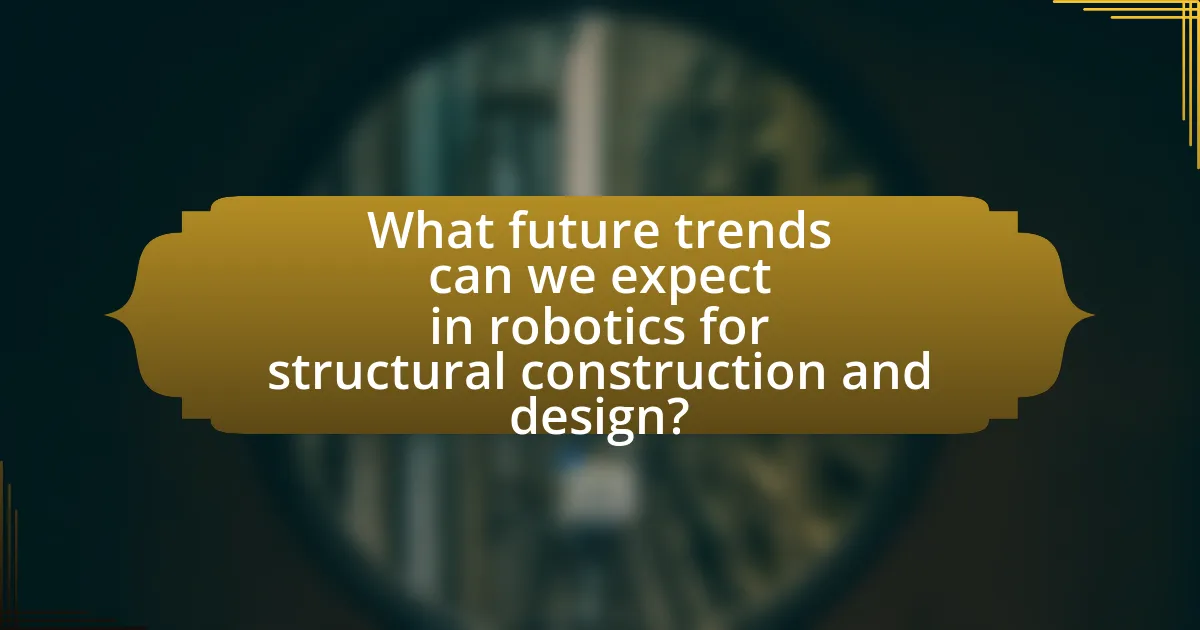The article examines the significant impact of robotics on structural construction and design, highlighting advancements in efficiency, precision, and safety. It details the current utilization of robotic systems, including automated bricklaying, 3D printing, and robotic arms, which streamline construction processes and reduce labor costs. Key benefits of integrating robotics include enhanced accuracy, cost savings, and improved collaboration among stakeholders. The article also addresses challenges in implementation, such as high initial costs and the need for skilled labor, while exploring future trends like artificial intelligence and collaborative robots that will shape the construction industry.

What is the Impact of Robotics on Structural Construction and Design?
The impact of robotics on structural construction and design is significant, enhancing efficiency, precision, and safety in building processes. Robotics automates repetitive tasks, such as bricklaying and welding, which reduces labor costs and minimizes human error. For instance, the use of robotic arms in prefabrication allows for consistent quality and faster assembly times, as demonstrated by projects like the MX3D bridge in Amsterdam, where a robotic arm was used to 3D print a steel bridge, showcasing both innovation and structural integrity. Additionally, robotics facilitates complex designs that would be challenging to achieve manually, enabling architects to push the boundaries of creativity while maintaining structural stability.
How are robotics currently utilized in structural construction?
Robotics are currently utilized in structural construction primarily for tasks such as automated bricklaying, 3D printing of building components, and robotic arms for assembly. These technologies enhance efficiency, precision, and safety on construction sites. For instance, companies like Apis Cor have developed 3D printing robots that can construct entire buildings in a fraction of the time compared to traditional methods, significantly reducing labor costs and construction waste. Additionally, robotic arms, such as those used by Fastbrick Robotics, can lay bricks with high accuracy, achieving speeds of up to 1,000 bricks per hour. These advancements demonstrate that robotics are transforming structural construction by streamlining processes and improving overall project outcomes.
What types of robotic systems are employed in construction projects?
Robotic systems employed in construction projects include autonomous drones, robotic arms, and 3D printing robots. Autonomous drones are utilized for site surveying, monitoring progress, and inspecting hard-to-reach areas, enhancing efficiency and safety. Robotic arms are often used for tasks such as bricklaying and welding, providing precision and reducing labor costs. 3D printing robots enable the construction of complex structures with reduced material waste and time, exemplified by projects like the 3D-printed houses in Italy, which demonstrate the technology’s capability to streamline construction processes.
How do these robotic systems enhance construction efficiency?
Robotic systems enhance construction efficiency by automating repetitive tasks, which reduces labor costs and increases precision. For instance, robotic arms can perform tasks such as bricklaying and welding with a level of accuracy that minimizes material waste and rework. According to a study by the Massachusetts Institute of Technology, the use of robotics in construction can lead to a 20-30% increase in productivity and a significant reduction in project timelines. This efficiency is further supported by the ability of robotic systems to operate continuously without fatigue, allowing for faster project completion and improved overall workflow.
What are the key benefits of integrating robotics into structural design?
Integrating robotics into structural design enhances efficiency, precision, and safety in construction processes. Robotics can automate repetitive tasks, reducing labor costs and minimizing human error, which leads to higher quality outcomes. For instance, robotic systems can perform complex assembly tasks with a level of accuracy that surpasses manual labor, as evidenced by studies showing a reduction in construction time by up to 30% when robotics are employed. Additionally, robotics can operate in hazardous environments, thereby improving worker safety by minimizing human exposure to dangerous conditions. This integration not only streamlines workflows but also fosters innovation in design capabilities, allowing for more complex and creative structures that were previously unfeasible.
How does robotics improve accuracy in construction?
Robotics improves accuracy in construction by utilizing advanced automation and precision engineering techniques. Automated robotic systems can perform repetitive tasks with a high degree of consistency, reducing human error and ensuring that measurements and placements are exact. For instance, robotic arms equipped with sensors can lay bricks or assemble components with millimeter precision, which significantly enhances the overall quality of construction projects. Studies have shown that projects utilizing robotic technology can achieve up to 30% greater accuracy in alignment and positioning compared to traditional methods, thereby minimizing material waste and rework costs.
What cost savings can be achieved through robotic automation?
Robotic automation can achieve significant cost savings in structural construction and design by reducing labor costs, minimizing material waste, and increasing productivity. For instance, studies indicate that robotic systems can lower labor costs by up to 30% due to their ability to perform tasks more efficiently than human workers. Additionally, robotic automation can decrease material waste by approximately 20% through precise measurements and cuts, leading to lower material expenses. Furthermore, the increased speed of robotic operations can enhance overall productivity, allowing projects to be completed faster, which can result in reduced overhead costs. These factors collectively contribute to substantial financial savings in construction projects.
What challenges are faced when implementing robotics in construction?
Implementing robotics in construction faces several challenges, including high initial costs, integration with existing workflows, and the need for skilled labor. High initial costs arise from the investment in robotic technology and infrastructure, which can deter companies from adoption. Integration challenges occur as robotics must be seamlessly incorporated into traditional construction processes, requiring changes in project management and workflow. Additionally, the construction industry often lacks workers with the necessary skills to operate and maintain robotic systems, leading to a skills gap that can hinder effective implementation. These challenges are supported by industry reports indicating that while robotics can enhance efficiency and safety, the barriers to entry remain significant.
What are the technical limitations of current robotic technologies?
Current robotic technologies face several technical limitations, including limited dexterity, insufficient sensory perception, and challenges in human-robot collaboration. Limited dexterity restricts robots from performing complex tasks that require fine motor skills, as most robotic arms are designed for repetitive, precise movements rather than intricate manipulation. Insufficient sensory perception hinders robots’ ability to accurately interpret their environment, which is crucial for tasks like navigation and obstacle avoidance. Additionally, challenges in human-robot collaboration arise from difficulties in communication and coordination, making it hard for robots to work seamlessly alongside human workers. These limitations impact the efficiency and effectiveness of robotics in structural construction and design, as highlighted by studies indicating that robots struggle to adapt to dynamic environments and unexpected changes in task requirements.
How do workforce dynamics change with the introduction of robotics?
The introduction of robotics significantly alters workforce dynamics by automating repetitive tasks, which leads to a shift in job roles and skill requirements. As robots take over manual and routine jobs, human workers are increasingly required to focus on complex problem-solving, oversight, and maintenance of robotic systems. For instance, a study by McKinsey & Company indicates that up to 30% of tasks in various industries could be automated by 2030, necessitating a workforce that is more skilled in technology and robotics. This transition can result in job displacement for low-skilled workers while simultaneously creating opportunities for higher-skilled positions in programming, robotics maintenance, and system management.

How does robotics influence the design phase of construction projects?
Robotics significantly influences the design phase of construction projects by enhancing precision, efficiency, and collaboration. Automated systems, such as Building Information Modeling (BIM) integrated with robotic tools, allow for real-time data analysis and visualization, leading to more accurate designs. For instance, a study by the National Institute of Standards and Technology found that using robotics in design can reduce errors by up to 30%, thereby minimizing costly rework. Additionally, robotics facilitates the exploration of complex geometries and innovative materials, enabling architects and engineers to push design boundaries while ensuring structural integrity.
What role do robotics play in architectural design processes?
Robotics play a crucial role in architectural design processes by enhancing precision, efficiency, and creativity in construction. Automated systems can execute complex tasks such as 3D printing, robotic assembly, and material handling, which significantly reduce human error and labor costs. For instance, the use of robotic arms in prefabrication allows for intricate designs to be realized with high accuracy, as demonstrated in projects like the ICD/ITKE Research Pavilion, where robotic fabrication techniques enabled the creation of complex geometries that would be difficult to achieve manually. Additionally, robotics facilitate rapid prototyping and iterative design, allowing architects to test and modify their concepts quickly, thereby fostering innovation in architectural practices.
How can robotics facilitate innovative design solutions?
Robotics can facilitate innovative design solutions by enabling precise automation and enhancing creativity in structural construction. Automated robotic systems can execute complex tasks with high accuracy, allowing architects and engineers to explore unconventional designs that would be difficult or impossible to achieve manually. For instance, robotic fabrication techniques, such as 3D printing and robotic arms, have been used to create intricate geometries and customized components, as demonstrated in projects like the “Digital Grotesque,” which showcases the potential of robotic technology in producing complex architectural forms. This integration of robotics not only streamlines the construction process but also expands the possibilities for design innovation, ultimately leading to more efficient and aesthetically unique structures.
What software tools are integrated with robotics for design optimization?
Software tools integrated with robotics for design optimization include Autodesk Fusion 360, Rhino with Grasshopper, and Siemens NX. Autodesk Fusion 360 offers cloud-based collaboration and generative design capabilities, allowing users to optimize designs based on performance criteria. Rhino with Grasshopper provides parametric design tools that enable complex geometries and automation in the design process. Siemens NX integrates advanced simulation and manufacturing capabilities, facilitating the optimization of designs for robotic applications. These tools enhance efficiency and precision in structural construction and design by leveraging computational algorithms and real-time data analysis.
How does robotics affect collaboration among construction stakeholders?
Robotics enhances collaboration among construction stakeholders by improving communication, efficiency, and data sharing. Automated systems facilitate real-time updates and feedback, allowing architects, engineers, and contractors to work more cohesively. For instance, robotic process automation can streamline project management tasks, reducing delays and miscommunication. A study by the McKinsey Global Institute found that implementing robotics in construction can increase productivity by up to 20%, which directly correlates with improved stakeholder collaboration as teams can focus on strategic decision-making rather than routine tasks.
What communication improvements arise from robotic integration?
Robotic integration in structural construction and design enhances communication by facilitating real-time data exchange and improving coordination among project stakeholders. This integration allows for seamless communication between robots and human workers, enabling instant feedback and adjustments during construction processes. For instance, studies have shown that the use of robotic systems can reduce miscommunication errors by up to 30%, as robots can relay precise information about project status and requirements directly to team members. Additionally, the implementation of robotic systems often incorporates advanced sensors and communication technologies, which further streamline information flow and enhance collaborative efforts on-site.
How do robotics enhance project management in construction?
Robotics enhance project management in construction by improving efficiency, accuracy, and safety throughout the construction process. Automated systems, such as drones and robotic arms, streamline tasks like surveying, material handling, and assembly, which reduces the time required for project completion. For instance, a study by the McKinsey Global Institute found that automation in construction could increase productivity by up to 50%. Additionally, robotics minimize human error, leading to higher quality outcomes and fewer costly reworks. The integration of robotics also enhances safety by taking on hazardous tasks, thereby reducing the risk of accidents on-site.

What future trends can we expect in robotics for structural construction and design?
Future trends in robotics for structural construction and design include increased automation, enhanced precision, and the integration of artificial intelligence. Automation will streamline construction processes, reducing labor costs and time, as evidenced by the use of robotic arms in prefabrication, which can produce components faster than traditional methods. Enhanced precision will be achieved through advanced robotic systems that utilize sensors and machine learning to ensure accuracy in measurements and placements, minimizing errors and waste. The integration of artificial intelligence will enable robots to adapt to changing conditions on-site, optimizing workflows and improving safety. These trends are supported by ongoing research and development in robotics, such as the work conducted by the Massachusetts Institute of Technology, which explores robotic systems capable of autonomously constructing complex structures.
How is artificial intelligence shaping the future of robotics in construction?
Artificial intelligence is significantly shaping the future of robotics in construction by enhancing automation, improving safety, and optimizing project management. AI algorithms enable robots to perform complex tasks such as bricklaying and welding with precision, reducing labor costs and increasing efficiency. For instance, a study by the McKinsey Global Institute found that automation could increase productivity in construction by up to 20-30%. Additionally, AI-driven robots can analyze site conditions in real-time, allowing for better decision-making and risk management, which leads to safer work environments. This integration of AI not only streamlines construction processes but also fosters innovation in design and structural integrity.
What advancements in robotics technology are on the horizon?
Advancements in robotics technology on the horizon include enhanced automation through collaborative robots (cobots), improved artificial intelligence for decision-making, and advancements in robotic materials and mobility. Collaborative robots are designed to work alongside humans, increasing efficiency and safety in construction environments. AI advancements enable robots to analyze complex data and make real-time decisions, optimizing construction processes. Additionally, innovations in materials, such as soft robotics and exoskeletons, enhance mobility and adaptability, allowing robots to navigate diverse construction sites more effectively. These developments are supported by ongoing research and investment in robotics, indicating a significant shift in how structural construction and design will be approached in the near future.
How will the role of human workers evolve alongside robotic systems?
The role of human workers will evolve to focus more on oversight, collaboration, and complex problem-solving as robotic systems take on repetitive and hazardous tasks in structural construction and design. Human workers will transition from performing manual labor to managing and programming robotic systems, ensuring safety, and integrating advanced technologies into workflows. For instance, a study by McKinsey Global Institute indicates that automation could enhance productivity by up to 30% in construction, allowing human workers to concentrate on tasks requiring creativity and critical thinking, such as design innovation and project management. This shift will necessitate new skills and training for workers to effectively collaborate with robotic systems, ultimately leading to a more efficient and safer construction environment.
What best practices should be followed when adopting robotics in construction?
When adopting robotics in construction, best practices include thorough planning, integration with existing workflows, and continuous training for personnel. Thorough planning ensures that the specific needs of the project align with the capabilities of the robotic systems, which can enhance efficiency and safety. Integration with existing workflows allows for seamless collaboration between human workers and robotic systems, minimizing disruptions and maximizing productivity. Continuous training for personnel is crucial, as it equips workers with the necessary skills to operate and maintain robotic systems effectively, thereby reducing the risk of accidents and improving overall project outcomes. These practices are supported by industry studies indicating that projects utilizing robotics with proper planning and training experience up to a 30% increase in productivity and a significant reduction in on-site injuries.
How can companies effectively train their workforce for robotic integration?
Companies can effectively train their workforce for robotic integration by implementing a structured training program that combines hands-on experience with theoretical knowledge. This approach ensures that employees understand both the operational and technical aspects of robotics. For instance, companies can utilize simulation software to provide a safe environment for workers to practice robotic operations before engaging with actual machinery. Additionally, incorporating workshops led by robotics experts can enhance understanding and address specific challenges faced in the workplace. Research indicates that organizations that invest in comprehensive training programs see a 20% increase in productivity and a significant reduction in errors related to robotic tasks.
What strategies can be employed to ensure a smooth transition to robotic systems?
To ensure a smooth transition to robotic systems in structural construction and design, organizations should implement comprehensive training programs for employees. These programs should focus on familiarizing workers with robotic technologies, enhancing their technical skills, and addressing any concerns regarding job displacement. Research indicates that companies that invest in employee training during technological transitions experience a 30% increase in productivity and a 25% reduction in operational errors. Additionally, establishing a phased implementation plan allows for gradual integration of robotic systems, minimizing disruptions and enabling teams to adapt effectively. This approach has been supported by case studies showing that gradual adoption leads to higher acceptance rates among staff and better overall project outcomes.

Leave a Reply